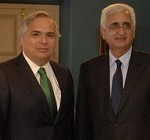The on-going visit of Indian Foreign Minister Salman Kurshid to Chile and Argentina from February 5-8 is a welcome development. Though India is cutting a higher profile in world affairs, the visits of its various foreign ministers to Latin America and the Caribbean (LAC) have been few and far between. This is the first visit by an Indian foreign minister to Chile. Such exchanges at the highest levels, be it between heads of government or senior Cabinet ministers, give bilateral relationships the much-needed momentum to move forward. This is especially true for India and Latin America, which have much to offer to each other, but where links between its political elites have been scarce.
There is no country in the world farther away from India than Chile. Yet, what we have seen over the past decade is proof that, though we may not be living at the end of history, we are at the end of geography as we know it.
Globalization has facilitated much of this change, and India and Chile have certainly made the most of it as part of the Global South.
Since 1990, Chile (sometimes referred to as “the Singapore of South America”) has had one of the highest growth rates of any country outside Asia, with an average annual growth rate of 5%. India too has had an impressive growth rate averaging between 6 and 7%. Chile’s development is led by its exports, and driven by a “lateral” international trade policy whose centerpiece are bilateral or plurilateral Free Trade Agreements. The country’s exports increased nine-fold from $9 billion in 1990 to $78 billion in 2012. Last year, Chile received a record Foreign Direct Investment of $26.4 billion, second only to Brazil in the region. India, while relying more on its domestic market, has also made enormous strides in exports, especially in IT and IT-enabled services, where it is now a world-class player.
There are various complementarities between both economies: Chile is the world’s leading copper producer and exporter, and an agricultural, fishing and forestry powerhouse; India is a producer of many industrial inputs and consumer products at competitive prices. Still, despite this, there was little going on between both countries even in 2003, when bilateral trade was in the range of a mere $300-400 million. No Chilean president had ever visited India either.
Yet, over the past decade, a sea change has taken place in Indo-Chilean relations, much as it has in India’s ties with other LAC nations. In only four years, bilateral trade increased six-fold, reaching approximately $2.5 billion. A Preferential Trade Agreement (PTA) was then signed in 2006. Two presidential visits took place – by Chilean Presidents Ricardo Lagos and Michelle Bachelet in 2005 and 2009 respectively, and Indian President Pratibha Patil in 2008. A third presidential visit to India, this time by incumbent President Sebastián Piñera, is in the offing.
Though Santiago practices development diplomacy, i.e. one designed to foster economic growth and prosperity, it is also strongly committed to Latin American regionalism. As pro-tempore chair of the Community of Latin American and Caribbean States (CELAC), Chile led CELAC at the First Indo-Latin American Dialogue in New Delhi last August, an unprecedented encounter between India and LAC’s apex regional body. This was followed by the first Sino-LAC Dialogue in Beijing, and more recently, by the VII EU-LAC Summit in Santiago on 26-27 January. The remarkable ability of the CELAC troika (Chile, Cuba and Venezuela) to work together this past year, despite ideological differences, shows the impetus that Latin America’s new, so-called post-liberal regionalism embodied in entities such as CELAC and UNASUR, has acquired.
But to fully understand the change in India-Chile economic relations, we must go back to 1971. At the time, Chilean President Salvador Allende and India’s Prime Minister Indira Gandhi met at an international conference. Mrs. Gandhi, who had visited Chile in 1968 and knew Allende from then, expressed India’s interest in buying copper from Chile. Allende promised to look into it. Because of the lead time of supply contracts, and the freight cost from Chile to India, this was not possible. Allende, ever the gentleman, sent a special envoy to explain the situation to Mrs. Gandhi. Thirty six years later, in 2007, Chile exported $2 billion worth of copper to India, and India is exporting cars, industrial machinery and much else to Chile. Today, the PTA signed six years ago is being expanded upon. Chile and India, two powerhouses in the Global South, can take these ever growing links to greater heights. Their growing relationship is also emblematic of the new era in Indo-LAC relations.
Jorge Heine, a former Ambassador of Chile to India, is CIGI Chair in Global Governance at the Balsillie School of Foreign Affairs, Wilfrid Laurier University, and a Distinguished Fellow at the Centre for International Governance Innovation, in Waterloo, Ontario. His latest book, La Nueva India, is published by El Mercurio/Aguilar.
This article was exclusively written for Gateway House: Indian Council on Global Relations. You can read more exclusive content here.
For interview requests with the author, or for permission to republish, please contact outreach@gatewayhouse.in.
© Copyright 2013 Gateway House: Indian Council on Global Relations. All rights reserved. Any unauthorized copying or reproduction is strictly prohibited


